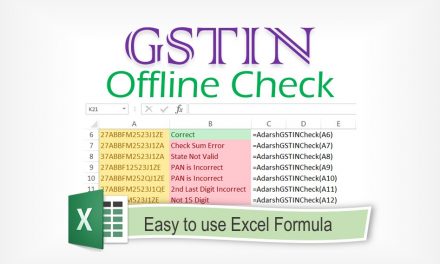
Vendor Master data analytics
Vendor data management is very important, specially for large organizations. This article highlights what risks arise if Vendor Master data is not properly managed.
Vendor Master is stored not in just one data table, but spread across many tables depending upon EPR used. On a broader level we can classify this info as below based on Importance and Risk.
- Vendor Site information
- Contact Person Information
- Tax Number – PAN & Sales Tax
- Vendor Classification
- Customers and Employees Marking
- Credit Limit
Problem – Phone, Email or Fax Numbers are not captured for Vendor Site records
Implications / Risk
- Could create significant impact on operational efficiency as the contact information needs to be maintained in spreadsheets outside the ERP systems.
- Creates significant barriers to any automation or system driven processing which is based on the ERP database.
- Duplicate checks as part of Data Quality analysis are impacted due to unavailability of data.
- Creation of Vendor Master records without capture of Contact information is not in line with best practices.
Problem – Contact Person information have not been captured
i.e. Information relating to Contact Person on the Vendor’s side such as Contact person, Department, Phone Number, Email Address etc have not been captured in the Vendor Master
Implications / Risk
- Could create significant impact on operational efficiency as the contact information needs to be maintained in spreadsheets outside the ERP systems.
- Creates significant barriers to any automation or system driven processing which is based on the ERP database.
- Duplicate checks as part of Data Quality analysis are impacted due to unavailability of data.
- Creation of Vendor Master records without capture of Contact information is not in line with best practices.
Problem – Contact Person information is incomplete
Implications / Risk
- Could create significant impact on operational efficiency as the contact information needs to be maintained in spreadsheets outside the ERP systems.
- Creates significant barriers to any automation or system driven processing which is based on the ERP database.
- Duplicate checks as part of Data Quality analysis are impacted due to unavailability of data.
- Creation of Vendor Master records with incomplete capture of Contact information is not in line with best practices.
Problem – PAN and ST Registration number is being captured
i.e. PAN and ST Registration numbers are being captured for only few records contained in the Vendor master (PO_Vendors)
Implications / Risk
- Lack of adequate information would adversely impact multiple activities such as Statutory reporting, quoting in documents such as PO and for duplicate checks on Vendors.
- Creates significant barriers to any automation or system driven processing which is based on the ERP database.
- Creation of Vendor Master records with incomplete tax registration numbers is not in line with best practices.
- Duplicate checks as part of Data Quality analysis are impacted due to unavailability of data.
Problem – PAN and ST registration are captured in the same field
i.e. In the Vendor Master table (PO_Vendors), the flex field “Attribute7” [or similar filed] is used to store PAN of some Vendors and ST registration of some other vendors.
Implications / Risk
- Creates inconsistency in the data contained in the field and would adversely impact multiple activities such as Statutory reporting and Compliance, quoting in documents such as PO.
- Creates significant barriers to any automation or system driven processing which is based on the ERP database.
- Creation of Vendor Master records with one field containing both PAN and sales tax registration numbers is not in line with best practices.
Problem – One-time Vendor flags are not activated during creation
i.e. One-time Vendor flags are not being activated during creation of Vendors. Therefore none of the Vendors are automatically de-activated in the system but have to be manually de-activated.
Implications / Risk
- Requires significant effort in tracking outside the ERP system and manual deactivation of One-Time Vendors
- Lack of de-activation of One-time Vendors could cause transactions to occur with rejected Vendors.
- Causes a huge increase in the number of Vendors in the Masters and operational difficulties in Master Maintenance.
- Creates significant barriers to any automation or system driven processing which is based on the ERP database.
Problem – Vendors who fall in the Small Business category are not identified at creation
i.e. – Determination and capture of vendors which are classified as Small Business is not being carried out during creation of Vendor Master record
Implications / Risk
- Creates operational difficulties and requires a separate exercise to meet statutory reporting requirements such as total owing to Small and Micro Enterprises
- Creates significant barriers to any automation or system driven processing which is based on the ERP database.
Problem – Vendors are not classified by category
Implication / Risk
- Creates operational difficulties in managing and maintenance of the Vendor Master.
- Creates significant barriers to any automation or system driven processing which is based on the ERP database.
- Creates significant barriers to any automation or system driven processing which is based on the ERP database.
- Not having vendor classification is not in line with best practices.
Problem – Duplicate Vendors
- Duplicate Vendor names in the Vendor master, with minor differences in names due to special characters or spaces included in the names.
- Analysis of the first 10 characters in the Vendor name which are similar and possible instances of duplicate Vendors.
- Duplicate Vendor Addresses in the Vendor Master
- Duplicate Vendor addresses with minor differences due to spaces included
- Duplicate phone numbers in Vendor Master indicative of duplicate vendors
Implication / Risk
- Duplicate Vendors would create difficulties in Vendor balance tracking and management
- Could lead to blacklisted Vendors not being completely eliminated from Vendor Master
- Creates significant barriers to any automation or system driven processing which is based on the ERP database.
- This is not in line with leading practices.
Problem – Unsystematic data entry
- Vendor Address field is blank or populated with junk characters
- Unsystematic entry of data due to the inclusion of special characters in addresses
- Unsystematic entry of data due to inclusion honorifics in names. i.e. Vendor Name fields and non-standardized and include titles such as “M/s� and “M/S�
- Unsystematic entry of data due to the inclusion of special characters in names. i.e. Vendor Name fields and non-standardized and include special characters such as “-� , “.� and “&� in vendor records
Implication / Risk
- Such non-standard entry of data could result in creation of duplicate records.
- Creates difficulties in sorting and ordering of records and therefore impacts Vendor Management and reporting
- May break interfacing if Vendor Master data flows from One ERP to another.
- Creates significant barriers to any automation or system driven processing which is based on the ERP database.
- This is not in line with leading practices.
Problem – Details of Vendors who are also Customers or Employees is not captured
Implication / Risk
- Would be required for Statutory reporting purposes and also from a Vendor/Customer management perspective.
- Tracking of Employees who are Vendors is required from a Fraud Management perspective
Problem – Credit Limits information is not being captured in Vendor master tables
Implication / Risk
- Data on credit limits and alerts on credit exposures to Vendors would not be available to enable Spending decisions
- Creates significant barriers to any automation or system driven processing which is based on the ERP database.
- Credit limits not being captured for vendors, is not in line with best practices.














